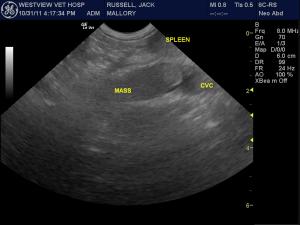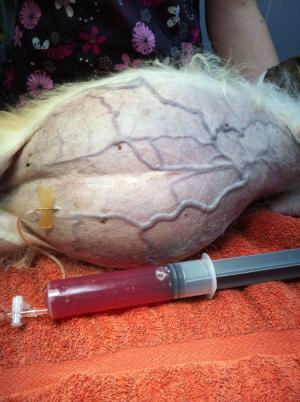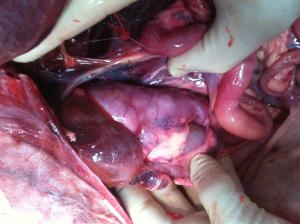Clinical Differential Diagnosis
(Lobetti): 1. Liver disease - neoplasia, cirrhosis, chronic-active hepatitis
2. Intra-abdominal neoplasia
3. Vena cava obstruction - compression, invasion, thrombosis
Image Interpretation
(Lindquist): Image 1: Mildly echogenic ascites is noted around the urinary bladder. Image 2-3: Long axis view of a mass invading the caudal vena cava with color flow demonstrating an obstructive process. Images 4-6: Left adrenal mass invading the vena cava. Image 7: Passive congestion pattern is noted in the liver with dilated hepatic vein to the right of the diaphragm and dilated CVC cranial to the diaphragm. Image 8: Passive congestion of the hepatic veins is noted with heterogenous liver parenchyma and mildly echogenic but normal sized GB. Image 9: Severe dilation of the CVC is noted as it passes through the diaphragm. The arrows demonstrate the walls of the CVC that is expanded and invaded by the mass. Image 10: Severe abdominal distention and venous congestion prior to therapeutic abdominocentesis that was repeated as needed over 18 months. Images 11-12. Progressed adrenal mass expansion in the CVC as it passes through the diaphragm not allowing for hepatic vein drainage into the CVC. Hence ascites continues to form 6 months from the original diagnosis of invasive left adrenal tumor. Image 13: Right parasternal short axis heart based view demonstrates progressive adrenal mass/thrombus extension into the right atrium and into the tricuspid annulus by means of the thoracic vena cava. Images 14-15: Post mortem images of the invasive left adrenal adenocarcinoma 18 months after the original diagnosis was made.
Sonographic Differential Diagnosis
Left adrenal mass with vena caval invasion to the level of the right atrium.
Passive congestion and secondary ascites.
Hepatic portal hypertension, hepatomegaly with no signs of metastasis.
Sampling
Sampling: US-guided Cytology revealed left adrenocortical carcinoma at initial diagnosis.
DX
Post-mortem histopathology confirmed left adrenal cortical adenocarcinoma.
Outcome
Outcome: The patient was euthanized after 18 months form the original diagnosis of left adrenal mass and CVC invasion. Palliative therapy and weekly drainage of abdominal fluid created owing to portal hypertension and vena caval obstruction by the mass.









Comments